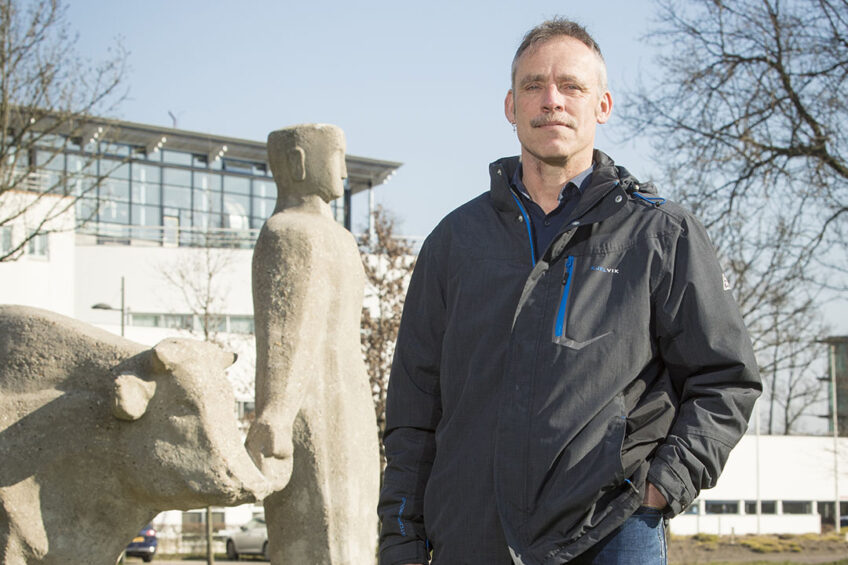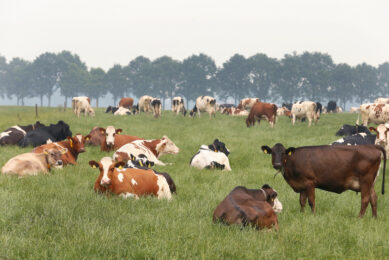Many possibilities to lower emissions through feed

Jan Dijkstra, animal feed expert at Wageningen University & Research (WUR), sees many possibilities to decrease nitrogen, ammonia, phosphate and methane through the proper use of feed.
Cattle farmers and consultants play it too safe when it comes to feed concentrates, according to Jan Dijkstra. They are afraid of a decreased milk production, so they maintain a dosage that is too high. This surplus finds its way into the animal’s urine in the form of nitrogen and it dissipates as ammonia. “On average, farmers feed 16,5% raw protein in the ration. This can be brought down to 15,5% without any loss of milk production, which leads to a decrease in ammonia emission of nearly 10%. That is enormous.” He takes the Irish approach as an example. This country’s law dictates that derogation participants can only use feed concentrates with less than 15% raw protein next year. Dijkstra: “This is not possible in the Netherlands, unfortunately. We do not have a government agency like the Irish one, that checks the maximum amount of protein or can make exceptions to this rule.”

What part can the compound industry play?
“There are possibilities for feed concentrates. Low-protein feed concentrate is an option, but you should always look at it in connection to protein from grass (silage). The quality of feed concentrates will become a focal point, especially the protein quality. Durability and quickly or slowly degradable fibers come into view here. In the future, using specific amino acids in protein may come into play.”
Can the problems with nitrogen/ammonia, phosphate and methane be solved through an ideal feed measure?
“That would be fantastic, but it mostly just conflicts. A measure that works is a silage maize ration. This is low in protein, has a better nitrogen efficiency, with less nitrogen and ammonia emission and less phosphate. It also has a lower methane emission than grass.”
Jan Dijkstra, animal feed expert at Wageningen University & Research (WUR) says: “On average, cattle farmers feed too much protein. Feed companies should assume the role of feed expert and consultant and should focus less on selling as many tons of product as possible. Only suggest high protein when it is actually necessary.”
A silage maize ration is favourable, but the derogation actually curbs silage maize cultivation by increasing the grassland cultivation norm from 70 to 80%.
“This is a shame, but the derogation exists because of the amount of nitrate in groundwater. The nitrate concentration under maize land on sandy soil is twice as high as on grassland. You must then consider the best option. Nitrogen efficiency has worsened in the last four years due to a decrease in maize cultivation because of derogation and drought. The increase to 80% should be reversed or it should become even lower than 70%. A combination of protein from grass and starch from maize yields a higher nitrogen efficiency and is better for the environment. When you cultivate the soil properly and cultivate a good catch crop, you can achieve a lot with modern silage maize cultivation.”
1% extra fat in the feed leads to 5% less methane.
You also recommend mowing grass early with a dry matter yield between 2.000 and 2.500 kilogrammes per hectare. That solves two problems: optimal feed and less methane?
“Young grass goes hand in hand with low-protein feed. Protein from young grass is by far the cheapest and its quality comes close to the protein quality of feed concentrates. Mowing and feeding every day is ideal, optionally adding silage maize. The grass should not grow above 15 centimetres for a pasture cut. Take your grass level meter into the field several times a week. That way, you can achieve a decrease in methane emission of 30%, which is a big step for the environment. However you do it, do not let the grass grow for too long, because this leads to a decrease in feed quality. Roughage quality is the foundation for feeding well.”
Shouldn’t the government reward such a decrease in methane?
“That will be the case someday, but decreasing nitrogen is the first point on the government’s agenda. This can be done through compound feed or roughage (or both), to get a ration that is lower in protein. The rule here is: what does not go in, does not come out. It can be quite hard to manage. On average, cattle farmers feed too much protein. When milk production does not run smoothly, feed consultants often suggest putting more protein in the ration, because it increases milk production. When you do not know the underlying cause, you just advise to use more protein. Chances are that production increases and that the customer is happy.”
Would that not only worsens the nitrogen and methane problems?
“The whole sector needs to be convinced that it should get to work to fix this. When the sector itself does not spring into action, the government will forcefully intervene. Enter a covenant about protein in compound feed and about methane, which is what happened with phosphate in the Netherlands. Feed companies should assume the role of feed expert and consultant and should focus less on selling as many tons of product as possible. Only suggest high protein when it is actually necessary. Advise as well as possible, fitting the cattle farmer’s needs for an optimal operating result but also fitting society’s needs for the environment. Keep the importance of the sector within the socially accepted image in mind: without a ‘license to produce’, cattle farming deteriorates.”
Recent research indicates that low phosphorous during the drying off period can help to prevent low calcium levels in the blood in the first day/days after calving.
The DSM feed supplement Bovaer is being developed right now for methane. Adding this methane blocker leads to 20% less emission. You have conducted research on this in Wageningen. What is the status of this miracle agent?
“The good thing about Bovaer is that it is persistent. For many other methane blockers, long-term effectiveness is still a question mark. The European Food Safety Authority must decide about its admission now. This should come through somewhere at the end of 2020, but corona research may cause delays.”
20% less emission: direct implementation?
“It costs the cattle farmer more money, without the extra milk yield in return. If the government wants to reduce methane, it can either do so through punishments or rewards. In this case, large environmental benefits can be obtained through rewards. The greenhouse gas production per kilogramme of milk can be specified per farm, which the government can use a reward or punishment standard.”
Can the compound feed industry do more?
“Of course, for example by adding extra fat to feed. 1% extra fat leads to 5% less methane. You can go to roughly 7% fat, not too high. More fat does mean more expensive feed. Choose unsaturated fatty acids. Rumen resistant saturated fat can have a negative impact on cheese processing.”
How about phosphate?
“In the Netherlands, thanks to the covenant, phosphate excretion has already decreased significantly. It can decrease even more, with millions of kilogrammes. In the Netherlands, every kilogramme of milk contains 1.010 milligrammes of phosphorous on average. The numbers indicate that this can decrease by at least 3 kilogrammes per lactation. The fear of a phosphorous shortage is almost always unnecessary. The challenge for the compound feed industry lies in low-phosphorous feed. Recent research indicates that low phosphorous during the drying off period can help to prevent low calcium levels in the blood in the first day/days after calving. It helps to prevent ketosis in much the same fashion.”
Cows are exceptionally good at converting protein into milk
Microorganisms in the rumen make sure that a cow can eat feed that humans cannot consume. Jan Dijkstra calculated how well cows do this compared to humans. He looked at products containing protein that humans could also have eaten. The cow’s yield is 3,5 times as high. Because of this yield alone, it is attractive to use even more residual products from human consumption. Dijkstra also mentions the reintroduction of animal meal, which is currently prohibited because of BSE. A large part of it is usually burned or used in biogas installations. “What a waste,” notes Dijkstra. Thanks to modern DNA techniques, it is easily preventable that animals consume meal of the same species. “Start allowing it in poultry and pig feed and prevent for example the large imports of soy.”
And ammonia?
“Nitrogen in urine with ammonia emission as a result, is largely avoidable. Ensure a proper balance between rumen degradable protein and rumen degradable carbohydrates (for energy). This leads to less nitrogen in the cows’ urine. In the future, it will become even more important to prevent the disbalance between energy absorbed from the gastrointestinal tract and absorbed amino acids, leading to less nitrogen in the urine. Farmers can manage this using compound feed and by watching the durability of nutrients, depending on the feed system.”

What are the possibilities for using other raw materials?
“Low-protein raw materials are almost always low in phosphorous too. There is much variation between these raw materials. Soybean meal for example has a better balance between protein and phosphorous than rapeseed meal. There are possibilities for starchy by-products such as potatoes. Grains also work very well, such as crushed wheat and soda grain, which is used to unlock the wheat with caustic soda. You can also process different protein sources, such as field beans, seaweed and algae, but also insect protein (which is not formally admitted yet, ed.). We should close the mineral cycle locally or regionally, for example by using waste flows. We also need to keep developing knowledge to use nitrogen and phosphorous as sparsely as possible.”
Tell me about choosing durable raw materials which can mean more expensive feed.
“Cheap can also mean expensive in the long run. You need to keep the eventual value of the milk and meat in mind. Precise feeding is necessary no matter what.”
How does that work?
“It is a challenge and requires much customisation to feed the animals individually. It will be possible in the future with all kinds of sensors, but we are not quite there yet. Larger farms can work with production groups, which is a great step to refine even more. Managing in the parlour is easiest and it is most effective for nitrogen, ammonia and methane. It gets more difficult for animals in the pasture. You can add little with compound feed, so you need to focus on your grass management. Make sure that high quality roughage is a focal point.”
Join 13,000+ subscribers
Subscribe to our newsletter to stay updated about all the need-to-know content in the dairy sector, two times a week.










